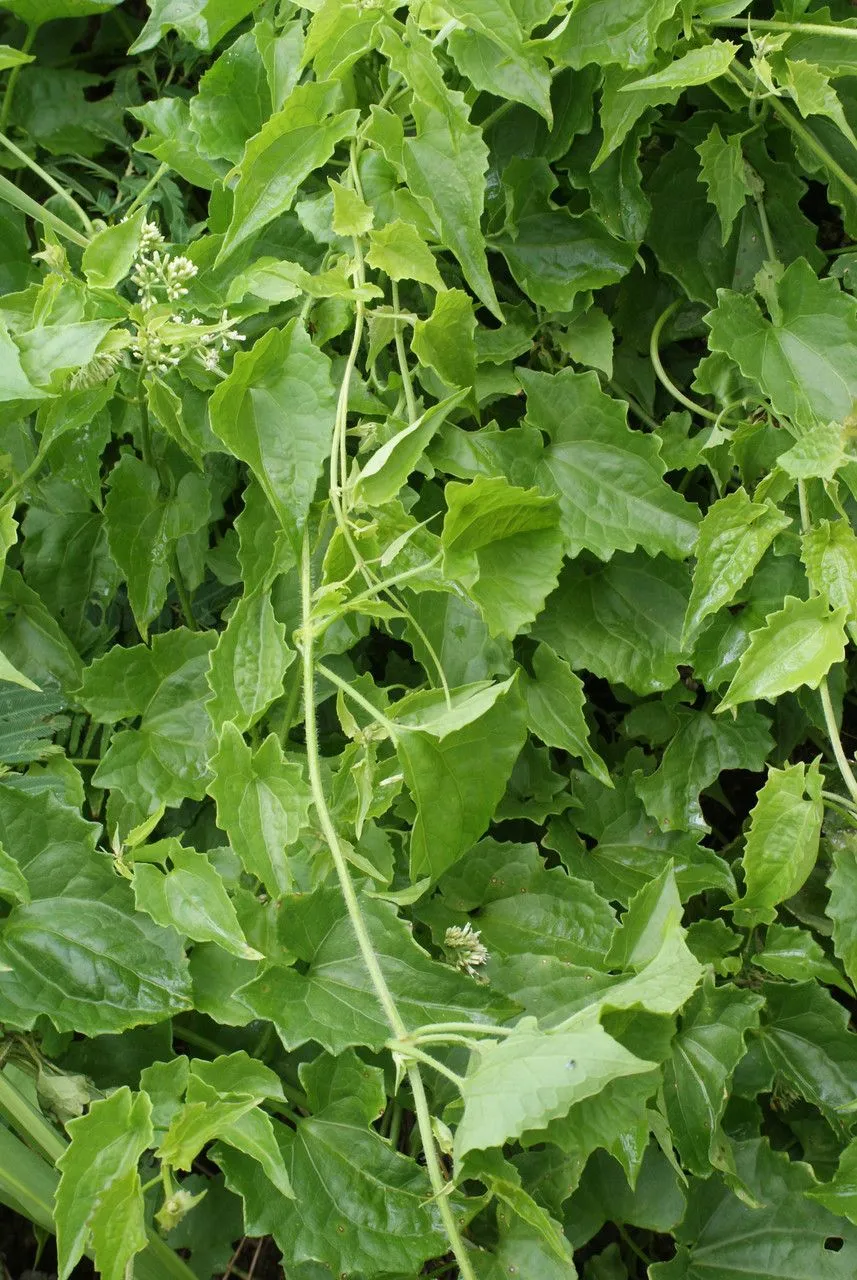
Author: Kunth
Bibliography: Nov. Gen. Sp. 4: 105 (1818)
Year: 1818
Status: accepted
Rank: species
Genus: Mikania
Vegetable: False
Observations: Trop. & Subtrop. America
Climbing hempweed, scientifically known as Mikania micrantha, is a vigorous and perennial vine that belongs to the Asteraceae family. This fast-growing plant is notorious for its invasive tendencies, particularly in tropical and subtropical regions of the Americas where it flourishes in the warm and humid climate.
First described by Kunth in 1818 in “Nov. Gen. Sp. 4: 105,” climbing hempweed has since been studied extensively due to its significant environmental and agricultural impact. The plant features heart-shaped leaves and small, creamy-white flowers that grow in tight clusters, often forming dense mats that can engulf other vegetation. These dense mats can smother native plants, leading to decreased biodiversity. The rapid growth and spread of Mikania micrantha pose a threat to agriculture because it can overrun crops, reduce yields, and increase the cost of weed management.
Climbing hempweed reproduces both sexually, via seeds, and vegetatively, through stem fragments, making it remarkably resilient and difficult to control. Its seeds are dispersed by the wind and water, allowing the plant to spread over considerable distances quickly. Furthermore, the plant’s stems can root at the nodes when they come into contact with the soil, enabling new plants to establish themselves from just a small cutting.
Efforts to manage Mikania micrantha include mechanical removal, chemical herbicides, and biological control methods. However, each approach has its challenges. Mechanical methods are labor-intensive and often only provide temporary relief, as the plant can resprout easily. Chemical treatments may harm non-target species and lead to environmental concerns. Biological control, such as introducing natural enemies like insects or pathogens that target Mikania micrantha, is a promising but complex strategy requiring careful implementation to avoid unintended ecological consequences.
Despite its problematic nature, climbing hempweed’s rapid growth and dense foliage provide interesting study opportunities for researchers looking to understand invasive species dynamics and develop effective management strategies. Understanding the biology and ecology of Mikania micrantha is crucial in mitigating its spread and protecting native ecosystems and agricultural areas from its invasive reach.
Eng: chinese creeper, mile-a-minute, bittervine, climbing hempweed, mikania-vine, mile-a-minute weed
Msa: selaput tunggul
Fra: liane americaine, liane-serpent
En: Climbing hempweed, Mikania-vine, Mile-a-minute, Bittervine, Chinese creeper, Mile-a-minute Weed, American rope, Bitter tally, Bitter-tally, Falso Guaco, Mikenia, Bitter vine
Zh: Wei gan ju, 小花蔓泽兰, 小花蔓澤蘭, 薇甘菊
Fr: Liane-serpent, Liane americaine, Baume céleste, Herbe margoze
De: Chinesischer Sommerefeu
Ht: Bwa zamann
Ms: Selaput tunggul
Ml: ധൃതരാഷ്ട്രപ്പച്ച
Pt: Guaco
Pt-br: Guaco-verdadeiro, Carobinha
Es: Guaco falso
Su: Areuy
Zh-tw: 小花蔓澤蘭
Th: ขี้ไก่ย่าน
Zh-hant: 小花蔓澤蘭
Taken May 16, 2020 by prasun sarkar (cc-by-sa)
Taken Dec 24, 2020 by Flo Mertensia (cc-by-sa)
Taken Dec 24, 2020 by Flo Mertensia (cc-by-sa)
Taken Aug 28, 2020 by jay cee (cc-by-sa)
Taken Dec 22, 2021 by Sanjay Pal (cc-by-sa)
Taken Oct 12, 2022 by Blue Bottle (cc-by-sa)
Taken Jul 1, 2022 by ben vc (cc-by-sa)
Taken Jan 1, 1900 by EOL − Carrington, S. (cc-by-nc-sa)
Taken Feb 28, 2017 by Tela Botanica − Liliane ROUBAUDI (cc-by-sa)
Taken Feb 28, 2017 by Tela Botanica − Liliane ROUBAUDI (cc-by-sa)
© copyright of the Board of Trustees of the Royal Botanic Gardens, Kew.
© copyright of the Board of Trustees of the Royal Botanic Gardens, Kew.
© copyright of the Board of Trustees of the Royal Botanic Gardens, Kew.
Taken Jul 29, 2015 by OTS – Oviedo-Brenes, Federico (cc-by-nc-sa)
Taken Nov 11, 2022 by Ronan Gamero (cc-by-sa)
Taken Apr 29, 2016 by Thomas Delhotal (cc-by-sa)
Taken Apr 29, 2016 by Thomas Delhotal (cc-by-sa)
Taken May 29, 2016 by laurence comte (cc-by-sa)
Taken Feb 28, 2017 by Tela Botanica − Liliane ROUBAUDI (cc-by-sa)
Taken Feb 28, 2017 by Tela Botanica − Liliane ROUBAUDI (cc-by-sa)
Taken Apr 18, 2020 by Amado Rosane (cc-by-sa)
Taken Apr 18, 2020 by Amado Rosane (cc-by-sa)
Taken Apr 17, 2019 by OTS – R. Aguilar (cc-by-nc-sa)
Taken Apr 17, 2019 by OTS – R. Aguilar (cc-by-nc-sa)
Taken Nov 19, 2004 by Royal Botanic Garden Edinburgh – Bhaskar Adhikari (cc-by-nc)
Taken Jan 19, 1996 by Royal Botanic Garden Edinburgh – Bhaskar Adhikari (cc-by-nc)
Taken Jan 20, 2012 by EOL − Carina Chicaiza (cc-by-nc)
Growth habit: Vine
Family: Myrtaceae Author: (F.Muell.) K.D.Hill & L.A.S.Johnson Bibliography: Telopea 6: 402 (1995) Year: 1995 Status:…
Family: Rubiaceae Author: Pierre ex A.Froehner Bibliography: Notizbl. Bot. Gart. Berlin-Dahlem 1: 237 (1897) Year:…
Family: Sapindaceae Author: Koidz. Bibliography: J. Coll. Sci. Imp. Univ. Tokyo 32(1): 38 (1911) Year:…
Family: Asteraceae Author: A.Gray Bibliography: Pacif. Railr. Rep.: 107 (1857) Year: 1857 Status: accepted Rank:…
Family: Fabaceae Author: Medik. Bibliography: Vorles. Churpfälz. Phys.-Ökon. Ges. 2: 398 (1787) Year: 1787 Status:…
Family: Aspleniaceae Author: (Cav.) Alston Bibliography: Bull. Misc. Inform. Kew 1932: 309 (1932) Year: 1932…